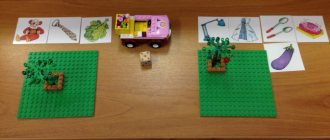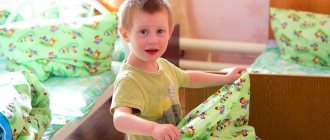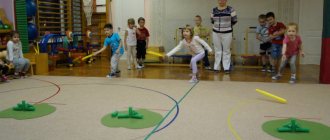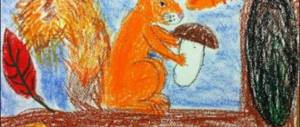Preparatory stage
Entertainment “Rucheyok” is folklore. For decades, it was used for fun at Maslenitsa, festivities, and fairs.
The fun has 3-4 interpretations. Kindergarten teachers use a simplified version. The goal of the fun is to have time to walk along the lined corridor in the allotted time.
Rules for active fun:
- 8 players (4-5 pairs) take part;
- odd number of participants;
- musical accompaniment;
- an adult (parent, teacher) directs the play activity;
- leader – child (if possible);
- a clear explanation of the rules to the children before the fun begins.
Age division
Russian folk game “Stream” The complexity of the gameplay depends on the age of the participants. For younger children, use the simplified version.
Game rules for kids
Start introducing young children (from 3 years old) to the fun “Stream” with a simplified version. Progress of entertainment:
- players stand in a round dance together with an adult leader;
- the accordion player and one baby stand in the center;
- The round dance begins to move along with the playing of the button accordion, the children and the teacher (parent) pronounce a play rhyme;
- the baby chooses one from the circle, they hold hands and raise them up, forming an arc;
- participants run through the lined gates and stand in a circle;
- the one chosen remains inside, and the one who chose stands in a round dance;
- actions are repeated.
It is not necessary to use musical accompaniment. However, it develops a sense of rhythm in the players and makes the game more fun.
Rules of the game for preschoolers
For preschool children, the rules and goals of the game “Stream” change slightly, but they change. Management of the game process is given to an adult. Make sure that an odd number of players take part. A child can also be the leader. The actions are performed in order:
- children go into pairs, preferably a boy and a girl;
- participants line up one after another with their hands raised up, forming a house or corridor;
- one of the players left without a pair stands at the end of the column;
- the presenter pronounces a game rhyme, the player without a partner prepares to run;
- after the leader’s words, the participants say a phrase, and the child standing alone runs and chooses one of the participants;
- after choosing, the teacher turns on the music for 10-30 seconds, depending on the length of the corridor;
- during this time the couple overcomes the distance and stands first;
- the child goes back without a mate.
What else to read The edible-inedible game: fun options
If the children did not manage to pass through the stream in the allotted period of time, then the chosen person returns to duty, and the one who chooses gets a second try.
Progress of the game:
Option 1.
4-5 children stand on one side of the playground. On the opposite side (distance 12-15m)
flags on the benches and chairs . At the signal - “One, two, three - run!”
children run to
the flags and raise them . The one who did it first is noted. Then the guys go to the place , the next 4-5 children come out.
Option 2.
Run, overcoming an obstacle - crawl under a rope, climb through a hoop, walk along a bench.
"Find yourself a mate"
Goal: to teach children to run in different directions without bumping into each other, and to find a mate when given a signal. Reinforce different types of running. Cultivate a sensitive attitude towards each other.
What words to say?
There are several interpretations of poems and phrases that are used during fun. In the version for children, a classic, perky poem about a loaf is suitable.
“Stream” for older children, the presenter pronounces any quatrain about a stream. After this, those standing in pairs say: “You run faster, choose a friend!”
The chooser has his own phrase: “I will find/love Mashenka (name of another participant) and take him with me!” Kids can use it.
Don't forget, folklore entertainment. You can come up with rhymes yourself, borrow them from other entertainment programs, and download them for free on the Internet.
The creation of new rules is welcome. For the children who did not have time to run along the corridor, come up with a comic punishment. This could be a funny dance, squats, or reciting a poem.
“The Sparrows and the Car” is a complicated version.
- First, you need to prepare the children for the game by asking them about sparrows: what they know about sparrows, how they fly, what they eat, where they live. Next, add to the already known information that sparrows fly away at the sight of an approaching car. Explain why the birds are afraid that the car might crush their paws.
- Ask if the guys want to learn how to play a new game. Explain to them the rules: act strictly on the signal; sparrows and cars should not appear on the road at inopportune times.
- The older group can be taken out into the yard. There's more room to run.
- In the yard, a circle is drawn on the ground. This is the future playground. Circles, triangles and squares are drawn around the field, which symbolize the sparrows' houses.
- Next, the teacher announces: “Turn around yourself, turn into a sparrow!” After this, each sparrow is allocated a house “These are your nests, you won’t be crushed here!”
- After this, the teacher says: “It’s become quiet in the yard, there’s no one!” Fly, sparrows! and together with them he flaps his “wings”, chirps, and pecks grains.
- At this time, a song is sung: Birds, little birds We sat, sat and flew off for a walk! The birds have arrived, little birds! They pecked the grains and flapped their wings!” The birds fly out onto the site and begin to look for grains and chirp.
- At this moment, the teacher says that he will be a car, and, taking the steering wheel in his hands and beeping, drives towards the clearing, and the birds scatter to their nests.
- Children must have time to run out of the circle and take their nests before the car crosses the field. To give the children a break, the car can drive around the site longer.
- Whoever did not have time to run out and find the house is eliminated from the game, because the machine “crushed” its paw.
- After this, the car drives into the parking lot and announces: “Fly, sparrows!”
- After playing a couple of times, you can transfer the role of the car to one of the children. The teacher can only give verbal signals to the children. For a car it could be a horn, for children a chirp or the words “Fly, sparrows!” Roles can be changed as the game repeats.
- You can also use music as a signal, the cessation of which will mean a signal to fly away from the nests. The music track for the game “Birds and the Car” can be downloaded for free on the Internet.
- To further involve children in the process, you can make homemade props: paper beaks and wings for a sparrow, a steering wheel for a car, or even grains, which will then need to be collected during the game.
What else to read: Outdoor game “Colored Cars”
Musical accompaniment of the game "Stream"
The music for playing trickle can be selected in different ways. For the Russian folk version of “The Hoverfly”, Russian dance songs are suitable. Download them in mp3 and play them on your playing devices.
Use children's, playful dance or round dance songs, funny gypsy motifs. If you plan to provide entertainment at the event, then invite an accordion player.
If possible, use a musical instrument in smaller gameplay as well. A short story about the button accordion will allow the child to gain new knowledge.
Outdoor game “Sparrows and a car” and its goals:
- Teach children to run and dodge obstacles. Children's motor skills develop best during outdoor games.
- Explain to kids that a moving car is a danger that must be watched out for. And also that you need to run away from the car to a safe place, and not to the roadway (area).
- Learn to navigate in space and remember your place.
- Teach kids to obey their elders and follow instructions. Perceive signals and symbols.
- During the game, the child learns to fantasize and imagine himself in different roles, and these are the basics of analytical thinking.
- During the preparation process, if the teacher and the children prepare the props, the children’s creative potential will be revealed.
- Car children learn to be leaders who lead the game. This gives courage, confidence in yourself and your abilities. Good self-esteem is the key to success in life.
The game “Sparrows and a Car” for the 2nd junior group is an excellent didactic material that can teach a child a lot. The main thing is to be creative.
The usefulness of the game "Stream"
The entertaining process develops the child's reaction speed and communication skills. During the game, a friendly atmosphere reigns within the group. Children interact with each other, learn to listen to their peers.
At the same time, players get acquainted with ancient Russian culture and traditions. This develops thinking and contributes to the study of the history of the state.
Three-year-old children learn to pronounce words clearly. Fun for kids helps:
- teach them to listen to an adult;
- follow the rules;
- don't push;
- treat other participants with respect;
- create a friendly atmosphere;
- познакомиться;
- lead round dances.
What else to read: “Don’t stay on the floor” or “Keep your feet off the ground” - an active game familiar to millions
Outdoor game “Through the Stream”
Objectives: To develop dexterity in children, to practice jumping on both legs and in balance.
Description: Everyone playing sits on chairs, 2 cords are placed 6 steps from them, the distance between them is 2 meters - this is a stream. Children must use pebbles and planks to get to the other side without getting their feet wet. The planks are placed in such a way that children can jump with both feet from one pebble to another. According to the word “Let's go!” 5 children cross a stream. The one who stumbled steps aside to “dry his shoes.” All children must cross the stream.
Rules:
The loser is the one who steps foot into the stream.
You can only cross if there is a signal.
Options:
Increase the distance between the cords, go around objects, moving to the other side. Jump on one leg.
Outdoor game "Cat and Mouse"
Objectives: To develop in children the ability to quickly act on a signal, to walk while maintaining the shape of a circle. Practice running and catching.
Description: All players, except 2, stand in a circle, at arm's length, and join hands. The circle does not close in one place. This passage is called a gate. Two players are behind the circle, representing a mouse and a cat. The mouse runs outside the circle and in the circle, the cat follows it, trying to catch it. The mouse can run into the circle through the gate and crawl under the arms of those standing in the circle. The cat is only at the gate. The children walk in a circle and say: “Vaska is walking grey, his fluffy tail is white. Vaska the cat is walking. He sits down, washes himself, wipes himself with his paw, and sings songs. Vaska the cat will silently walk around the house and hide. Gray mice are waiting." After the words, the cat begins to catch the mouse.
Rules:
Those standing in a circle should not let the cat pass under their clasped hands.
The cat can catch the mouse around and in the circle.
The cat can catch and the mouse can run away after the word “waiting.”
Options:
Arrange additional gates, introduce 2 mice, increase the number of cats.
Outdoor game "Horses"
Objectives: To develop in children the ability to act on a signal, coordinate movements with each other, practice running and walking.
Description: Children are divided into 2 equal groups. One group depicts grooms, the other - horses. A stable is outlined on one side. On the other is a room for grooms, with a meadow between them. The teacher says: “Grooms, get up quickly and harness the horses!” The grooms, with the reins in their hands, run to the stables and harness the horses. When all the horses are harnessed, they line up one after another and, as directed by the teacher, walk or run. According to the teacher’s words “We have arrived!” grooms stop the horses. The teacher says “Go and rest!” Grooms unharness the horses and release them to graze in the meadow. They return to their places to rest. Horses calmly walk around the site, graze, and nibble grass. At the teacher’s signal, “Grooms, harness the horses!” The groom catches his horse, which runs away from him. When all the horses are caught and harnessed, everyone lines up behind each other. After 2-3 repetitions, the teacher says: “Take the horses to the stable!” The grooms take the horses to the stable, unharness them and give the reins to the teacher.
Rules:
The players change movements according to the teacher’s signal. At the signal “Go to rest,” the grooms return to their places.
Options:
Include walking on a bridge - a board placed horizontally or inclined, suggest different goals for the trip.
Outdoor game "Rabbits"
Objectives: To develop in children the ability to move in a team, to find their place on the playground. Practice crawling, running, and jumping on 2 legs.
Description: On one side of the site, circles are drawn - rabbit cages. Chairs are placed in front of them, hoops are tied vertically to them or a cord is stretched. A chair is placed on the opposite side - the watchman's house. Between the house and the rabbit cages is a meadow. The teacher divides the children into small groups of 3-4 people. Each group stands in a circle. “The rabbits are in cages!” - says the teacher. Children squat down - these are rabbits in cages. The teacher approaches the cages one by one and releases the rabbits onto the grass. The rabbits crawl through the hoop and begin to run and jump. The teacher says “Run to the cages!” The rabbits run home and return to their cage, crawling through the hoop again. Then the guard lets them out again.
Rules:
The rabbits do not run out until the guard opens the cages.
The rabbits return after the teacher’s signal “Get into the cages quickly!”
Options : Place a bench or chair in each cage according to the number of rabbits.





